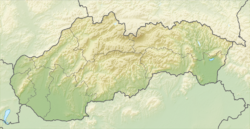- Malé Dvorníky
-
Malé Dvorníky
Kisudvarnok— village — Location of the village Coordinates: 48°00′40″N 17°38′35″E / 48.01111°N 17.64306°ECoordinates: 48°00′40″N 17°38′35″E / 48.01111°N 17.64306°E Country  Slovakia
SlovakiaRegion Trnava District Dunajská Streda First written mention 1336 Government[1][2] – Mayor Zoltán Marcell (Most-Híd) Area – Total 6.885 km2 (2.7 sq mi) Elevation 115 m (377 ft) Population (2001)[3] – Total 469 – Estimate (2008) 1,036 – Density 150/km2 (388.5/sq mi) Etnicity[3] – Hungarians 92,51 % – Slovakians 7,16 % Time zone EET (UTC+1) – Summer (DST) EEST (UTC+2) Postal Code 929 01 Area code(s) +421 31 Website www.kisudvarnok.sk Malé Dvorníky (Hungarian: Kisudvarnok, Hungarian pronunciation:[’kiʃudvɒrnok]) is a village and municipality in the Dunajská Streda District in the Trnava Region of south-west Slovakia.
Contents
History
I was an Avar settlement in the 6th century. The name of the village was first recorded in 1254 as "Odour". Until the end of World War I, it was part of Hungary and fell within the Dunaszerdahely district of Pozsony County. After the Austro-Hungarian army disintegrated in November 1918, Czechoslovakian troops occupied the area. After the Treaty of Trianon of 1920, the village became officially part of Czechoslovakia. In November 1938, the First Vienna Award granted the area to Hungary and it was held by Hungary until 1945. After Soviet occupation in 1945, Czechoslovakian administration returned and the village became officially part of Czechoslovakia in 1947. In 1946, a great number of local Hungarian families were deported to the Czech lands, but most of them were able to return later.
Demography
In 1910, the village had 445, for the most part, Hungarian inhabitants. At the 2001 Census the recorded population of the village was 894 while an end-2008 estimate by the Statistical Office had the villages's population as 1036. As of 2001, 92,51 per cent of its population was Hungarian while 7,16 per cent was Slovakian.
Roman Catholicism is the majority religion of the village, its adherents numbering 87.58% of the total population.[3]
Geography
The municipality lies at an altitude of 115 metres and covers an area of 6.885 km².
References
Dunajská Streda • Šamorín • Veľký Meder
Báč • Baka • Baloň • Bellova Ves • Blahová • Blatná na Ostrove • Bodíky • Boheľov • Čakany • Čenkovce • Čiližská Radvaň • Dobrohošť • Dolný Bar • Dolný Štál • Dunajský Klátov • Gabčíkovo • Holice • Horná Potôň • Horné Mýto • Horný Bar • Hubice • Hviezdoslavov • Jahodná • Janíky • Jurová • Kľúčovec • Kostolné Kračany • Kráľovičove Kračany • Kútniky • Kvetoslavov • Kyselica • Lehnice • Lúč na Ostrove • Macov • Mad • Malé Dvorníky • Medveďov • Michal na Ostrove • Mierovo • Nový Život • Ňárad • Ohrady • Okoč • Oľdza • Orechová Potôň • Padáň • Pataš • Povoda • Rohovce • Sap • Štvrtok na Ostrove • Topoľníky • Trhová Hradská • Trnávka • Trstená na Ostrove • Veľká Paka • Veľké Blahovo • Veľké Dvorníky • Vieska • Vojka nad Dunajom • Vrakúň • Vydrany • Zlaté Klasy Categories:
Categories:- Villages and municipalities in Dunajská Streda District
- Hungarian communities in Slovakia
Wikimedia Foundation. 2010.

